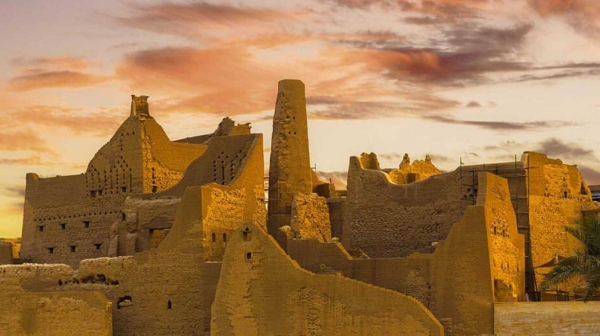
Diriyah: The heart of Saudi history
The history of Diriyah city goes back to 430 AD, when the ancient Arabian tribe of Banu Hanifa came to settle in eastern Nejd on the banks of the valley of Al-'Irdh, which later came to be known after them as ‘Wadi Hanifa’. Led by Ubaid bin Tha’labah, the tribe’s chieftain, they chose ‘Hajar al-Yamamah’ as their new hometown.
Then ‘Hajar’ flourished to be the greatest city in the region, which was ruled by the King of Al-Yamamah, Thumamah ibn Uthal Al-Hanafi, who lived during the time of the Prophet, may God bless him and grant him peace. He was the first Muslim to enter Makkah reciting the Talbiyah.
After that, the Arabian Peninsula lived through hard times of neglect, privation and dispute until 850 AH (1446 AD), when Diriyah was founded by a descendant of King Thumamah — Prince Mani’ bin Rabi’a al-Muraydi, who was the twelfth grandfather of Saudi Arabia’s founder King Abdulaziz, may God have mercy on him.
The city-state had a long history in the peninsula region, and the establishment of Diriyah was a political turning point. Prince Mani' and his descendants ruled the city and led it to become a cultural center, distinguished by its geographical location being on the crossroads of trade routes between the north and south of the Arabian Peninsula. Additionally, it contributed to the promotion of trade movement in and out of the neighboring regions.
In 1139 AH (1727), Imam Muhammad bin Saud, then 40 years old, established the First Saudi State, which lasted for 91 years until 1233 AH.
Imam Muhammad bin Saud loved solitude, meditation and contemplation, which spiritually empowered his keen personality and the talented visionary in him.
During his reign, the First Saudi State emerged in stages. Imam Muhammad bin Saud united Diriyah and strengthened it to be the capital of the state while paying attention to internal matters and reinforcing the community and uniting its members.
Thus Diriyah became the capital of a sprawling state, and a source of economic, social, intellectual and cultural attraction. As it embraced on its soil ancient archaeological landmarks such as the historic Ghasaiba neighborhood, Samhan district, the Bujairi area, the Diriyah market and Al-Turaif neighborhood, which was described as one of the largest Mud neighborhoods in the world and was registered by UNESCO on its list of human heritage.
In addition, the state's financial system was described as one of the distinguished systems in terms of balancing resources and expenditures.
This led to the migration of many scholars to Diriyah to receive education and authorship that was prevalent at its time, and many new schools of calligraphy and copying emerged.
After the fall of the First Saudi State in 1233 AH (1818), his grandson Imam Turki bin Abdullah was able to recapture Riyadh in 1240 AH (1824) after seven years of hard work and struggle.
Imam Turki was able to unify most of the parts of the Arabian Peninsula in a short period, continuing the sober approach on which the First Saudi State was established, which was to maintain security, education, justice and the elimination of division and rivalry. The state continued to rule the region until 1309 AH (1891) lasting for 67 years.
After a political vacuum and chaos in the center of the Arabian Peninsula, which lasted for nearly ten years, King Abdulaziz managed on the fifth of Shawwal 1319 AH (January 5, 1902) to re-establish the Saudi State after he recovered the city of Riyadh to start a new page of Saudi history and place a brick on the building blocks of unity, stability and development under the banner “There is no god but Allah, and Muhammad is His messenger.”
Subsequently, on the seventeenth of Jumada al-Ula 1351 AH corresponding to September 23, 1932, King Abdulaziz announced the unification of the Kingdom of Saudi Arabia after historical events that lasted 30 years.
This rich history deserves to be remembered by the sons and daughters of the Kingdom of Saudi Arabia, as it reflects the ancient history of the land, which extends back to more than three centuries.
Therefore, the honorable royal order was issued Thursday to set February 22 of every year as Foundation Day — a day to commemorate the founding of the First Saudi State.
Throughout its history, the Kingdom has formed a political weight in the region, benefiting from its distinguished geographical location and the wisdom of its leaders until it made it a point of balance regionally and at the level of the Middle East. Whilst the historical turn that the Saudi States has gone through confirmed the extent of what binds the citizens of the Kingdom and their brothers in the countries of the Cooperation Council for the Arab States of the Gulf (GCC).
From deep relationships that spanned for many centuries and took root over the years, what we see today is a product of the original efforts of the ancestors.
The Founding Day represents a dear national occasion that demonstrates the solidity and stability of the institution of governance and the state system in Saudi Arabia for more than three centuries. Regionally and globally, serving the two Qiblas and the guests of Rahman was a top priority for the imams of the Saudi State which was inherited by the kings of the Kingdom up to the Custodian of the Two Holy Mosques King Salman bin Abdulaziz Al Saud – may God protect him.
Achievements continued throughout the present era, including spreading stability in the state, which witnessed great prosperity in various fields, political independence without being subject to any influence in the region or outside.

























